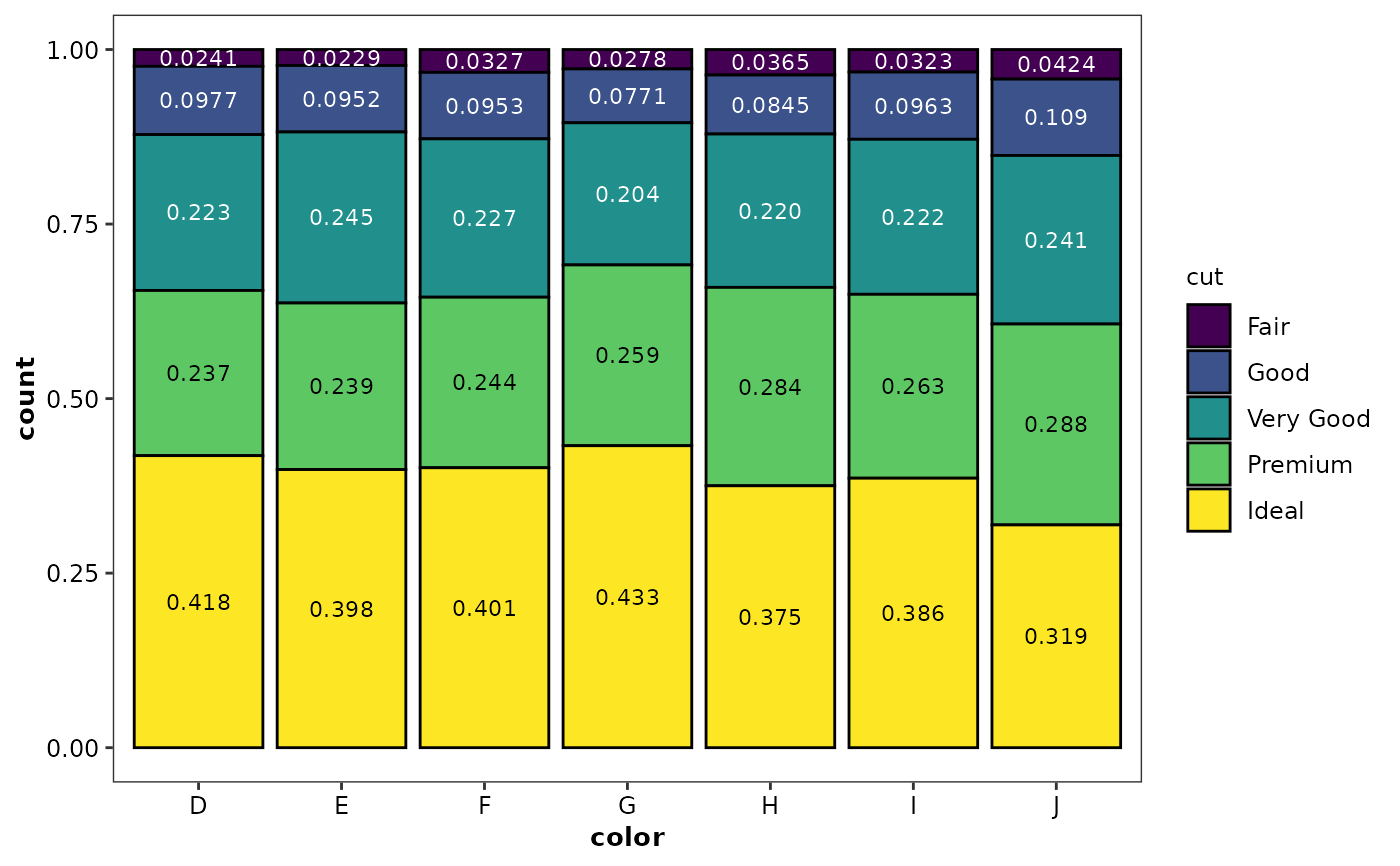This function is intended to work in combination with
geom_bar to display the sum of the values represented
by each bar. Like geom_bar, this function works if the
x and/or y aesthetics are provided.
geom_barcount(
mapping = NULL,
data = NULL,
stat = "barcount",
position = "stack",
...,
overall.stack = TRUE,
digits = 3,
width = NULL,
na.rm = FALSE,
orientation = NA,
show.legend = NA,
inherit.aes = TRUE
)
stat_barcount(
mapping = NULL,
data = NULL,
geom = "barcount",
position = "stack",
...,
overall.stack = TRUE,
digits = 3,
width = NULL,
na.rm = FALSE,
orientation = NA,
show.legend = NA,
inherit.aes = TRUE
)Arguments
- mapping
Set of aesthetic mappings created by
aes(). If specified andinherit.aes = TRUE(the default), it is combined with the default mapping at the top level of the plot. You must supplymappingif there is no plot mapping.- data
The data to be displayed in this layer. There are three options:
If
NULL, the default, the data is inherited from the plot data as specified in the call toggplot().A
data.frame, or other object, will override the plot data. All objects will be fortified to produce a data frame. Seefortify()for which variables will be created.A
functionwill be called with a single argument, the plot data. The return value must be adata.frame, and will be used as the layer data. Afunctioncan be created from aformula(e.g.~ head(.x, 10)).- position
Position adjustment, either as a string naming the adjustment (e.g.
"jitter"to useposition_jitter), or the result of a call to a position adjustment function. Use the latter if you need to change the settings of the adjustment.- ...
Other arguments passed on to
layer(). These are often aesthetics, used to set an aesthetic to a fixed value, likecolour = "red"orsize = 3. They may also be parameters to the paired geom/stat.- overall.stack
Defines whether an overall count is displayed for stacked bars or if the counts of each individual component of the stacked bars should be displayed.
- digits
Integer indicating the number of significant digits to be used. Recognized values are
0..22. Usedigits = 0to display as integers.- width
Bar width. By default, set to 90% of the
resolution()of the data.- na.rm
If
FALSE, the default, missing values are removed with a warning. IfTRUE, missing values are silently removed.- orientation
The orientation of the layer. The default (
NA) automatically determines the orientation from the aesthetic mapping. In the rare event that this fails it can be given explicitly by settingorientationto either"x"or"y". See the Orientation section for more detail.- show.legend
logical. Should this layer be included in the legends?
NA, the default, includes if any aesthetics are mapped.FALSEnever includes, andTRUEalways includes. It can also be a named logical vector to finely select the aesthetics to display.- inherit.aes
If
FALSE, overrides the default aesthetics, rather than combining with them. This is most useful for helper functions that define both data and aesthetics and shouldn't inherit behaviour from the default plot specification, e.g.borders().- geom, stat
Use to override the default connection between
geom_barcountandstat_barcount.
Orientation
This geom treats each axis differently and, thus, can thus have two orientations. Often the orientation is easy to deduce from a combination of the given mappings and the types of positional scales in use. Thus, ggplot2 will by default try to guess which orientation the layer should have. Under rare circumstances, the orientation is ambiguous and guessing may fail. In that case the orientation can be specified directly using the orientation parameter, which can be either "x" or "y". The value gives the axis that the geom should run along, "x" being the default orientation you would expect for the geom.
Aesthetics
geom_barcount() understands the following aesthetics (required aesthetics are in bold):
xylabelalphaanglecolourfamilyfontfacegrouphjustlineheightsizevjust
Learn more about setting these aesthetics in vignette("ggplot2-specs").
See also
Examples
library(ggplot2)
p <- ggplot(mpg)
p +
aes(x = class) +
geom_bar() +
geom_barcount()
 # Map class to y instead to flip the orientation
p +
aes(y = class) +
geom_bar() +
geom_barcount()
# Map class to y instead to flip the orientation
p +
aes(y = class) +
geom_bar() +
geom_barcount()
 # For stacked position
p <- ggplot(diamonds, aes(color, fill = cut))
p +
geom_bar(position = 'stack') +
geom_barcount()
# For stacked position
p <- ggplot(diamonds, aes(color, fill = cut))
p +
geom_bar(position = 'stack') +
geom_barcount()
 p +
geom_bar(position = 'stack') +
geom_barcount(overall.stack = FALSE)
p +
geom_bar(position = 'stack') +
geom_barcount(overall.stack = FALSE)
 # For dodged position
p +
geom_bar(position = 'dodge') +
geom_barcount(position = position_dodge(width = 0.9))
# For dodged position
p +
geom_bar(position = 'dodge') +
geom_barcount(position = position_dodge(width = 0.9))
 # For fill position
p +
geom_bar(position = 'fill') +
geom_barcount(position = position_fill())
# For fill position
p +
geom_bar(position = 'fill') +
geom_barcount(position = position_fill())
 # For fillpercent position
p +
geom_bar(position = 'fillpercent') +
geom_barcount(position = position_fillpercent()) +
ylab('count (%)')
# For fillpercent position
p +
geom_bar(position = 'fillpercent') +
geom_barcount(position = position_fillpercent()) +
ylab('count (%)')
